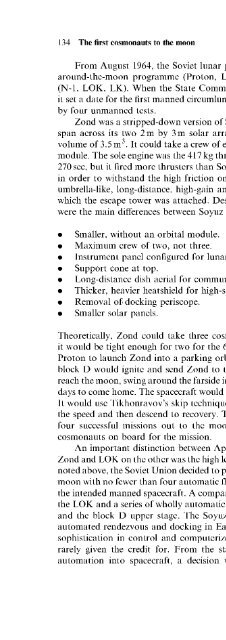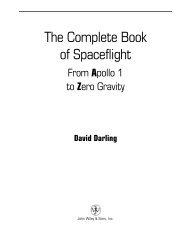Soviet and Russian Lunar Exploration
Soviet and Russian Lunar Exploration
Soviet and Russian Lunar Exploration
Create successful ePaper yourself
Turn your PDF publications into a flip-book with our unique Google optimized e-Paper software.
From August 1964, the <strong>Soviet</strong> lunar programme had been divided between the<br />
around-the-moon programme (Proton, L-1/Zond) <strong>and</strong> the manned lunar l<strong>and</strong>ing<br />
(N-1, LOK, LK). When the State Commission on the L-1 met in December 1966,<br />
it set a date for the first manned circumlunar flight of 26th June 1967, to be preceded<br />
by four unmanned tests.<br />
Zond was a stripped-down version of Soyuz. Its weight was 5,400 kg, length 5 m,<br />
span across its two 2 m by 3 m solar arrays 9 m, diameter 2.72 m <strong>and</strong> a habitable<br />
volume of 3.5 m 3 . It could take a crew of either one or two cosmonauts in its descent<br />
module. The sole engine was the 417 kg thrust Soyuz KDU-35 able to burn for about<br />
270 sec, but it fired more thrusters than Soyuz. Its heatshield was thicker than Soyuz<br />
in order to withst<strong>and</strong> the high friction on lunar reentry at 11 km/sec. It carried an<br />
umbrella-like, long-distance, high-gain antenna <strong>and</strong> on the top a support cone, to<br />
which the escape tower was attached. Designer was Yuri Semeonov. The following<br />
were the main differences between Soyuz <strong>and</strong> L-1 Zond. Zond was:<br />
• Smaller, without an orbital module.<br />
• Maximum crew of two, not three.<br />
• Instrument panel configured for lunar missions.<br />
• Support cone at top.<br />
• Long-distance dish aerial for communications.<br />
• Thicker, heavier heatshield for high-speed reentry.<br />
• Removal of docking periscope.<br />
• Smaller solar panels.<br />
Theoretically, Zond could take three cosmonauts; but, without an orbital module<br />
it would be tight enough for two for the 6-day mission. The mission profile was for<br />
Proton to launch Zond into a parking orbit. On the first northbound equator pass,<br />
block D would ignite <strong>and</strong> send Zond to the moon. Zond would take three days to<br />
reach the moon, swing around the farside in a figure-of-eight trajectory <strong>and</strong> take three<br />
days to come home. The spacecraft would have to hit a very narrow reentry corridor.<br />
It would use Tikhonravov's skip technique to bounce out of the atmosphere, killing<br />
the speed <strong>and</strong> then descend to recovery. The designers decreed that there should be<br />
four successful missions out to the moon, or a simulated moon, before putting<br />
cosmonauts on board for the mission.<br />
An important distinction between Apollo on the one h<strong>and</strong> <strong>and</strong> the Soyuz, L-1/<br />
Zond <strong>and</strong> LOK on the other was the high level of automation on <strong>Soviet</strong> spacecraft. As<br />
noted above, the <strong>Soviet</strong> Union decided to pave the way for a manned flight around the<br />
moon with no fewer than four automatic flights that precisely flew the same profile as<br />
the intended manned spacecraft. A comparable regime would have been followed for<br />
the LOK <strong>and</strong> a series of wholly automatic tests were set for the lunar l<strong>and</strong>er, the LK<br />
<strong>and</strong> the block D upper stage. The Soyuz system was designed to achieve entirely<br />
automated rendezvous <strong>and</strong> docking in Earth orbit. All this required a high level of<br />
sophistication in control <strong>and</strong> computerized systems, something the <strong>Russian</strong>s were<br />
rarely given the credit for. From the start, Korolev had built a high degree of<br />
automation into spacecraft, a decision which seems to have gone unchallenged







